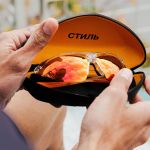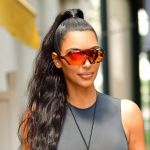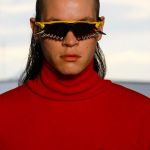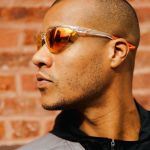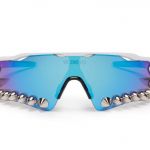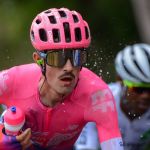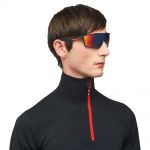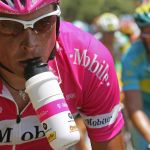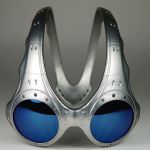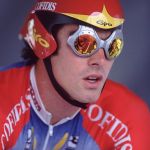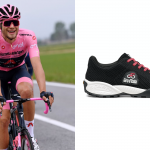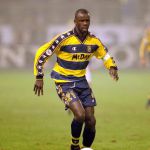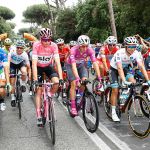
How cycling glasses moved from racing to catwalks
A trend that connects Prada, Oakley, Nike and Kim Kardashian
March 20th, 2019
Glasses are passed from being an object of utility to an accessory: more and more often brought together combining them with the dress you are wearing, the situation or to enhance your own features. Thus the true essence of this object, the utility, has been lost: they are used to enlarge objects, avoid direct exposure to sunlight or as a protection in the workplace.
Not only to cover the look before the departure but also to hide the looks toward the adversaries before the kilometer zero and not to make to shine through an expression that the behaviors of competition could reveal.
Not only a lens that separates the cyclist from the whole rest but also a utility function: if it is true that to win competitions they need to have legs, it is as many true that the guide for the cyclists, as in every sport and situation of life, are the eyes. Rain, wind, sun, mud, cold, aspects that are able, also only for a second, to make to lose to the athlete the orientation and to increase the risk of falls, so they can reveal fatal.

THE BEGINNING
At the beginning of the 20th century, the usefulness of eyewear was certainly recognized: no fashion could be glimpsed in a leather band with two large glass lenses, a model borrowed from aviators. They gave to athletes the appearance of explorers of the skies to the eyes of spectators. They had a protective function compared to the mud and the cold because when you climb the mountains, sweat becomes an enemy while icing on your eyebrows.
Until the 50s, sunglasses were not seen in cycling: athletes continued to use aviators, replacing leather with rubber, while Ray-Ban and Persol designed, produced and sold pairs of glasses that spread thanks to movie stars.
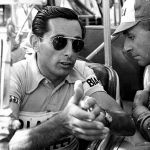
It was no accident that Fausto Coppi - an icon of style in the cycling world - was one of the first to use sun glasses. Coppi had the fisique du rol of the champion: he was winning races, looking always sharp and being a respected gentleman. He was a real star.
There were several cyclists who went against the tide, wearing glasses not to become icons of style, but out of necessity: Jan Jannsen won the 1968 Tour wearing eyeglasses as shortsighted and Laurent Fignon became "professor" wearing throughout his career round glasses.

BIG BRANDS
Since the 1950s Carrera developed sports glasses for skiing. Technological innovations have helped the movement of sunglasses, which became more comfortable, lighter and customizable due to thermoplastics and interchangeable lenses.
But the brand that will revolutionize eyewear in the sport was born in 1975 with an investment of three hundred dollars and a dog. An American used the name of his puppy to mark the motocross grips that he started selling after having patented the material. Soon he started selling masks for pilots and extended his range to other sports: already in 1985 Greg LeMond wore Oakley, and the following year he won the Tour de France. A frame borrowed from prescription models, a large lens that resembled ski masks. The addition of colors is a detail that perfectly fits into the iconic and popular Oakleys in the group: half of the professionals worn a pair of Eyeshade Spectrum, proving how the eyewear had definitely established itself in the cycling world.

But if Oakley was the precursor, many other brands soon began to produce and market new models that in addition to commercial competitiveness gave importance to an object that became the protagonist after being accessory since its first use. At the same time, the utility was lost: the interest of the amateurs was not aimed at wearing an excellent optical spectacle, but they wanted to feel part of a brand, just as it had been for a long time for the bikes that were purchased for the brand name. Briko and Bolle entered the market, but Oakley managed to amaze again: no runner would, in fact, have appeared as a "professor", as they presented glasses that integrated prescription lenses into the curved lens, combining utility with iconic style.
Pantani, Cipollini and Franco Ballerini chose Briko for their victories, while Germans including Jan Ullrich wore Rudy. But Oakley soon returned as market leader, presenting a model from a parallel dimension: the Over The Top model. If the first models of aviators made the cyclist an explorer of the skies, this model projected the cyclists directly on the Moon: an aluminum structure that towered over the head and eliminated the classic rods that rest on the ears, which resembled an astronaut's helmet. Another intuition to bring the brand to the center of media attention: the helmet was not yet mandatory and the model was clearly visible in every TV frame.
Specialized and Giro never managed to impose themselves at the levels of the American brand, risking to interrupt sales several times. However, the introduction of the helmet, whose aerodynamics is fundamental in time trials, allowed the brands that produced helmets to integrate lenses into the structure: Giro created a magnetic attachment that made the eyewear a unique piece.
In 2013 Ryder Hesjedal, the first and only Canadian to win the Giro d'Italia wore POC sunglasses: a romantic return to the origins, when the first cyclists wore the dark glasses used daily. A choice criticized by many but surely noticed by all: to date, the brand collaborates on one of the most iconic teams in the Pro Tour, EF Education First, combining its glasses with the brand new kits we have talked about here.
Oakley's dominance remains unchallenged, but it may soon tremble: the most iconic runner of the moment, Peter Sagan, has launched a collaboration with the 100percent brand that, just like Oakley, was born around 1980 producing motocross masks.
CYCLING EYEWEAR IN FASHION
In recent seasons, we have seen more and more use of cycling glasses by fashion designers, back on the catwalks of fashion and re-presented respecting their shape and current trends.
Kim Kardashian, Bella Hadid and Rita Ora, among others, were repeatedly seen wearing cycling models, in all cases they were Oakley. As in the sporting world, and not just the cycling world, even in fashion the American brand remains the most active and preferred, due to the quality and variety of lenses and frames. In 2018 Oakley presented a Fall-Winter collection in collaboration with the British designer Samuel Ross, a protagonist of the fashion scene and founder of the A-COLD-WALL brand*. The work of the British designer for the Californian brand continued also into the 2019 season, with a new collection made up of over 30 garments: t-shirts, baby carriers, jackets, but above all three models of glasses, which reflect those of cycling.
Not only the work of individual creatives has taken up the model of cycling glasses, but also Prada recently presented its line of lenses inspired by cycling models. These items matched perfectly with the taste of the Prada Linea Rossa collection relaunched taking up the streetwear garments that made history in the late 90s, reinterpreting them in a modern key. Even Vetements could not resist the temptation to use the silhouette of the Oakley Radar model in the SS19 collection, exploiting its color potential and customizing it with studs, applied to the lower part of the lenses. Heron Preston, again for his SS19 collection, had chosen Nike to make his own model of eyewear, the HP Tailwind, just a small part of the collaboration that tied the designer to the Beaverton brand. Innovative both in shapes and materials, with chrome and curved lenses, like the models worn by the greatest champions of modern cycling.
